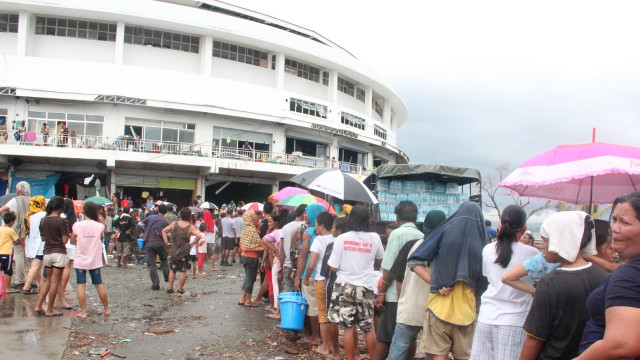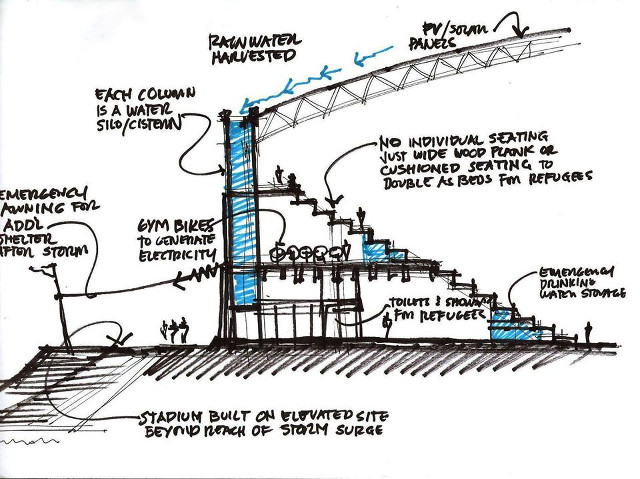SUMMARY
This is AI generated summarization, which may have errors. For context, always refer to the full article.

MANILA, Philippines – In the aftermath of Super Typhoon Yolanda (Haiyan), one building remained standing in Tacloban City, one of the worst-hit localities.
The Tacloban City stadium, now hailed by local and international media as “the one building that survived the storm,” sustained some damage to its roof but withstood Yolanda enough to serve as an evacuation center for thousands of homeless Taclobanons. (READ: Tacloban devastated; at least 100 dead)
In the Philippines’ long history of dealing with disasters, stadia have played an important role. After schools, barangay halls and covered courts, they are traditionally used as evacuation centers.
“Stadia are large enough to accommodate thousands. Even smaller arenas have space for hundreds. The concept is scalable,” explained architect and urban planner Paulo Alcazaren.
So what better structure to reconceptualize for disaster-proofing than the stadium?
In a 5-minute sketch posted on Facebook, Alcazaren proposed ways to make the stadium more resilient to disasters and climate change impacts. Climate change impacts refer to phenomena brought about by global warming such as droughts, flooding, heatwaves and more frequent typhoons.
Here are his recommendations:
1. There should be no regular seating, just planking or padded mats that can serve as beds for refugees.
2. Every column of the stadium should feature a silo or cistern which can collect rainwater from the roof. The water can then be used for the stadium’s urinals and showers. Installing a filiter can make the water drinkable, providing at least temporary stocks of fresh water until more relief goods arrive.
3. The stadium should feature more stalls, urinals and showers than the usual number.
4. Emergency power should come from generators but they should be augmented with solar panels, which convert solar energy into electricty, and pedal power, in which a foot pedal or crank is used manually to generate electricity.
5. The stadium should be built on elevated sites, safe from flooding or storm surge (flooding caused by a rise in sea level). It should be surrounded by flat areas for tents and helicopter landing zones.
6. An emergency clinic must be installed in the stadium with medical supplies always in stock.
7. It should have a shortwave radio station for emergency communication. In shortwave radio, radio waves are reflected back to Earth from the upper atmosphere allowing communication around the curve of the Earth. This makes shortwave radio perfect for two-way, long-distance communication. It is still being used for broadcasting voice and music and communication with ships and aircraft. This form of radio communication can be powered by batteries and does not need power from the grid. It can reach Manila and other countries.

Retrofitting the ‘bahay kubo’
The time has never been so ripe for typhoon-proof, climate-resilient buildings.
Any photo of the aftermath of Typhoon Yolanda (Haiyan) makes one thing obvious: damage to homes, buildings and infrastructure was immense and horrific.
The National Disaster Risk Reduction and Management Council (NDRRMC) pegged the number of damaged houses at 273,375 in its November 15 update. Of these, 153,098 were totally destroyed.
These numbers have driven a call for typhoon-proof architecture – an urgent call, if the Philippines is to survive the coming storms. (READ: Battered church offers shelter from the storm)
Department of Environment and Natural Resources (DENR) Secretary Ramon Paje also has recommendations for typhoon-resilient housing. After observing most of the houses that survived Yolanda had cemented roofing, he said in an ANC interview:
“If possible, houses with the bahay kubo design concept with slanted roofs, even metal ones, must be retrofitted. When wind enters the house, that roof will fold. If possible, roofs must be flat and in slabs. This should be the case even for school buildings, government buildings.”
Even if these buildings may still be submerged by floods and storm surge, at least people can still have homes to come back to when the water recedes.
Alcazaren also said houses on stilts may be a good idea, especially for areas where flooding is a regular occurrence. Dwellings built for more than one family may also be stronger.
Yolanda convinced the environment chief of the need to rethink lowland settlements.
“95% of our population is beside the sea or near water bodies,” Paje said in a mix of English and Filipino.
“We have to move 150 meters above sea levels if we are to construct new settlements. That is what we’re looking for right now. These areas must have been analyzed for susceptibility to landslides, flooding and so on – and geologically-analyzed so we know what is underneath. Does it have bedrock and stable foundation?”
As the task of rebuilding communities faces people and government, there is a need to make sure redevelopment is done in a sustainable way.
Alcazaren emphasized, “Good design need not be expensive. Its just a matter of investing in building robust structures to address extreme conditions.” – Rappler.com
Add a comment
How does this make you feel?
There are no comments yet. Add your comment to start the conversation.